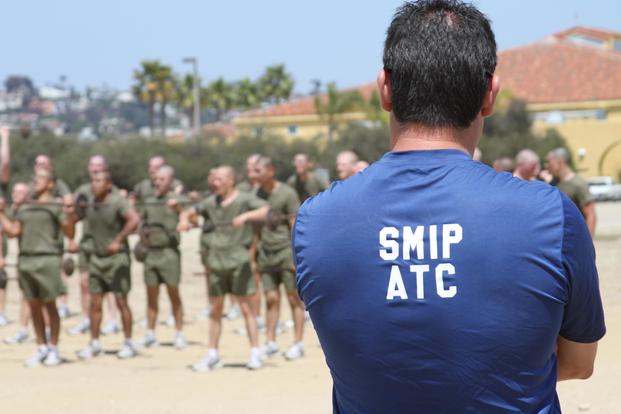MARINE CORPS BASE QUANTICO, Va. -- Marines will see dozens of athletic trainers hit the fleet over the next few years, giving leathernecks access to unit-level sports medicine for the first time since entry-level training.
The Marine Corps will invest up to $8.6 million annually on experienced athletic trainers over the next four years. Ten of the trainers will hit the operating forces by the end of next month, said Col. Stephen Armes, director of the service's Force Fitness Division.
Eventually, the three Marine expeditionary forces will each have 20 trainers assigned to them.
"The intent is to get them down as far as possible, at least to the regimental-group level and ideally down to the battalions," Armes told Military.com in an interview here. "... If you look at a collegiate football game, the ATs are on the sidelines, they're out at practice, they're working with the athletes."
Athletic trainers have been in place at the recruit depots for 15 years. From there, the program expanded to the follow-on schools of infantry as well as Officer Candidates School and The Basic School for officers.
Training and Education Command leaders have long wanted to push athletic trainers out to the operating forces after seeing the number of injured recruits who had to be sidelined during boot camp plummet with the introduction of sports medicine. When across-the-board spending cuts known as sequestration hit defense budgets in 2013, though, plans for expansion were left on the chopping block.
Now, the Marine Corps is taking a phased approach, approved by Commandant Gen. Robert Neller, to push the plan forward. The service will spend $1.3 million this fiscal year on the 10 athletic trainers, about $4.5 million in 2019 to bump the number to 33, and then $8.6 million a year from 2020 to 2022. That will bring the total number of trainers for the operating forces up to 66.
Armes and his team presented eight options to the commandant. The one Neller chose, he said, will "get them out to as many units as possible."
The hope is that athletic trainers, combined with the new Marine force fitness instructors who develop unit physical training plans, can spot injury trends. Medical privacy laws can make tracking injuries difficult, Armes said.
"We know a Marine is nondeployable, but we don't always necessarily know why," he said. "Is it an injury, pregnancy, sickness? We don't necessarily need to know who the Marine is, but we need to be able to track injury rates."
Since most of the injuries occurring during entry-level training are from overuse and in the lower extremities, Armes said they're fairly certain the same is happening at the MEF levels. Athletic trainers will work not only with force fitness instructors to adjust workouts to prevent the most common injuries, but can also encourage Marines to enter data about them into a new fitness smartphone application that's in the works.
Ultimately, he said, the key is to have the athletic trainers working closely with the Marines in their unit, just as they do at the recruit depots. They're meant to complement Navy medicine, not replace it.
"There's an old saying that it's easier for a commander to keep a Marine healthy than it is for a doctor to heal them," Armes said. "The athletic trainer program is really to ... keep Marines from being injured because that affects deployment numbers."
-- Gina Harkins can be reached at gina.harkins@military.com. Follow her on Twitter at @ginaaharkins.













